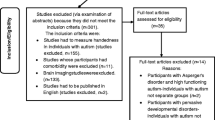Abstract
To test the hypothesis that the etiology of reading difficulties may differ for males and females in more severely impaired samples, reading performance data from monozygotic (MZ), same-sex dizygotic (DZss), and opposite-sex dizygotic (DZos) twin pairs were analyzed using a model-fitting implementation of the DeFries-Fulker (DF) model (Purcell & Sham, 2003, Behavior genetics, 33, 271–278). Five non-independent samples were selected using cut-offs of −1 (N = 737 pairs), −1.5 (N = 654), −2 (N = 468), −2.5 (N = 335), and −3 (N = 198) standard deviations (s) below the mean composite reading score of control twins. Male/female gender ratios for children with reading difficulties were significantly higher than 1.0 for all five samples and increased as a function of severity (viz., 1.15, 1.17, 1.40, 1.61, and 1.88, respectively). When the DF model was fit to the data, estimates of heritability (h 2g ) and shared environmental influences (c 2g ) were not significantly different for males and females in any of the groups. Consequently, the most parsimonious model that provided a good fit to the data at all five levels of severity equated the heritabilities and shared environmental influences for males and females, and fixed the DZos coefficient of genetic relatedness at 0.5. Thus, these results provide no evidence for a differential etiology of reading difficulties as a function of gender in more severely impaired samples, and suggest that the same genetic and environmental influences contribute to reading difficulties in males and females, irrespective of severity.
Similar content being viewed by others
References
DeFries J. C. (1985). Colorado reading project In: D. B. Gray, J. F. Kavanagh (eds) Biobehavioral measures of dyslexia Parkton, MD York Press pp. 107–122
DeFries J. C., Filipek P. A., Fulker D. W., Olson R. K., Pennington B. F., Smith S. D., Wise B. W. (1997). Colorado learning disabilities research center Learning Disabilities: A Multidisciplinary Journal 8:7–19
DeFries J. C., Fulker D. W. (1985). Multiple regression analysis of twin data Behavior Genetics 15:467–473
DeFries J. C., Fulker D. W. (1988). Multiple regression analysis of twin data: Etiology of deviant scores versus individual differences Acta Geneticae Medicae et Gemellologiae 37:205–216
DeFries J. C., Gillis J. J. (1993). Genetics of reading disabilities In: R. Plomin, G. E. McClearn (eds) Nature, nurture and psychology Washington, D.C. American Psychological Association pp. 121–145
DeFries J. C., Olson R. K., Pennington B. F., Smith S. D. (1991). Colorado Reading Project: Past, present, and future Journal of Learning Disabilities, 2:37–46
Dunn M. L., Markwardt F. C. (1970). Examiner’s manual: peabody individual achievement test Circle Pines, MN American Guidance Service
Finucci J. M., Childs B. (1981). Are there really more dyslexic boys than girls? In: A. Ansara, N. Geschwind, A. Galaburda, M. Albert, N. Gartrell (eds) Sex differences in dyslexia Townson, MD Orton Dyslexia pp. 1–9
Geschwind N. (1981). A reaction to the conference on sex differences in dyslexia In: A. Ansara, N. Geschwind, A. Galaburda, M. Albert, N. Gartrell (eds) Sex differences in dyslexia Townson, MD Orton Dyslexia pp. xiii–xviii
Harlaar N., Spinath F. M., Dale P. S., Plomin R. (2005). Genetic influences on early word recognition abilities and disabilities: A study of 7-year-old twins Journal of Child Psychology and Psychiatry 46:373–384
Hawke, J. L., Wadsworth, S. J., & DeFries, J. C. (2006). Genetic influences on reading difficulties in boys and girls: The Colorado Twin Study. Dyslexia, 12, 21–29
Liederman J., Kantrowitz L., Flannery K. (2005). Male vulnerability to reading disability is not likely to be a myth: A call for new data Journal of Learning Disabilities 38:109–129
Nass R. (1993). Sex differences in learning abilities and disabilities Annals of Dyslexia 43:61–77
Nichols R. C., Bilbro W. C. Jr. (1966). The diagnosis of twin zygosity Acta Geneticae Medicae et Gemellologiae 16:265–275
Olson R. K. (2002). Dyslexia: Nature and nurture Dyslexia 8:143–159
Purcell S., Sham P. C. (2003). A model-fitting implementation of the DeFries-Fulker model for selected twin data Behavior Genetics 33:271–278
Rutter M., Caspi A., Fergusson D., Horwood L. J., Goodman R., Maughan B., Moffitt T. E., Meltzer H., Carroll J. (2004). Sex differences in developmental reading disability: New findings from 4 epidemiological studies JAMA 291:2007–2012
Stevenson J. (1992). Identifying sex differences in reading disability: Lessons from a twin study Reading and Writing: An Interdisciplinary Journal 4:307–326
Symmes J. S., Rapoport J. L. (1972). Unexpected reading failure American Journal of Orthopsychiatry 42:82–91
Tallal P., Fitch R. H. (1993). Hormones and cerebral organization: Implications for the development and transmission of language and learning disabilities In: A. M. Galaburda (eds) Dyslexia and development: Neurobiological aspects of extra-ordinary brains Cambridge, MA Harvard University Press pp. 168–186
Torgesen J. K., Wagner R. K., Rashotte C. A. (1999). Test of word reading efficiency (TOWRE) Austin, TX Pro-ed
Vogel S. A. (1990). Gender differences in intelligence, language, visual-motor abilities, and academic achievement in students with learning disabilities: A review of the literature Journal of Learning Disabilities 23:44–52
Wadsworth, S. J., & DeFries, J. C. (2005). Genetic etiology of reading difficulties in boys and girls. Twin Research and Human Genetics, 8, 594–601
Wadsworth S. J., Knopik V. S., DeFries J. C. (2000). Reading disability in boys and girls: No evidence for a differential genetic etiology Reading and Writing: An Interdisciplinary Journal 13:133–145
Wechsler D. (1974). Examiner’s manual: wechsler intelligence scale for children-revised New York The Psychological Corporation
Wechsler D. (1981). Examiner’s manual: wechsler adult intelligence scale-revised New York The Psychological Corporation
Author information
Authors and Affiliations
Corresponding author
Rights and permissions
About this article
Cite this article
Hawke, J.L., Wadsworth, S.J., Olson, .K. et al. Etiology of reading difficulties as a function of gender and severity. Read Writ 20, 13–25 (2007). https://doi.org/10.1007/s11145-006-9016-z
Accepted:
Published:
Issue Date:
DOI: https://doi.org/10.1007/s11145-006-9016-z




